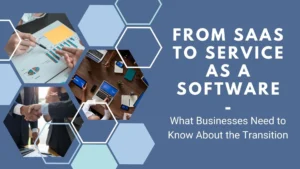The Service-as-a-Software (SaaS) industry is a critical component of the global software market, valued at approximately $200 billion in 2024 with an expected compound annual growth rate (CAGR) of 19.7% through 2028. SaaS platforms have transformed how businesses access and use software, emphasising flexibility, scalability, and cost-effectiveness. The industry spans across verticals like customer relationship management (CRM), enterprise resource planning (ERP), and collaboration tools, dominated by players like Salesforce, Microsoft (Azure), and Zoom.
Key Trends

- AI and Automation Integration
SaaS companies are embedding AI and machine learning into their platforms for predictive analytics, process automation, and enhanced customer insights. Examples include Salesforce’s Einstein AI and HubSpot’s AI-driven CRM features. - Vertical SaaS Solutions
Industry-specific SaaS platforms (e.g., healthcare, legal, or logistics) are gaining traction due to their tailored functionalities addressing niche market needs. - Focus on Cybersecurity
With increasing cybersecurity concerns, SaaS providers are prioritizing robust encryption, threat detection, and compliance with global regulations such as GDPR and CCPA. - Freemium and Usage-Based Pricing Models
Companies like Slack and Zoom lead the charge with models offering free tiers to attract users, with monetization through premium upgrades or usage-based billing. - Decentralised and Edge Computing
SaaS platforms are leveraging edge computing to improve latency and data processing efficiency, especially for IoT-based applications.
Opportunities

- Emerging Markets: SaaS adoption in developing countries is surging due to increased internet penetration and mobile connectivity.
- SME Market Expansion: Small and medium enterprises (SMEs) represent a growing customer base, driving demand for affordable, easy-to-implement SaaS solutions.
- Hybrid Work Environment Tools: Collaboration and communication tools that cater to hybrid work environments remain in high demand.
- Sustainability-focused SaaS: As businesses prioritise sustainability, SaaS platforms offering carbon tracking, resource management, and ESG reporting tools are poised for growth.
Challenges

- Data Privacy Regulations: Navigating the complexities of global data privacy laws poses significant compliance costs and challenges.
- Market Saturation: The growing number of SaaS providers creates intense competition, driving the need for differentiation through unique features and innovation.
- Customer Retention: High customer churn due to easy switching between competitors necessitates better customer engagement and support strategies.
Key Players Impacting the Industry
- Salesforce: Leading in CRM software with extensive AI integration.
- Microsoft Azure: A key player in cloud services and SaaS solutions like Microsoft 365.
- Adobe: Dominates the creative and marketing SaaS space with tools like Adobe Creative Cloud.
- ServiceNow: Specializes in workflow automation and enterprise service management.
- Zoho: Known for its affordable and integrated SaaS ecosystem for SMEs.
Forecast and Future Impact
- Short-Term (1-3 Years): AI-driven features and vertical SaaS growth will dominate the market. Increased M&A activity is expected as larger players acquire startups to enhance capabilities.
- Long-Term (4-8 Years): Decentralised SaaS systems utilising blockchain for security and transparency will emerge. Integration with augmented and virtual reality platforms is likely as businesses embrace the meta verse.
Business Implications
Companies leveraging SaaS must focus on differentiating through innovation, strengthening data security measures, and fostering customer loyalty to remain competitive. Emerging trends such as AI, vertical SaaS, and sustainability offer lucrative opportunities for investment and growth.

By understanding these dynamics, businesses can make informed decisions to capitalise on the evolving SaaS landscape.



